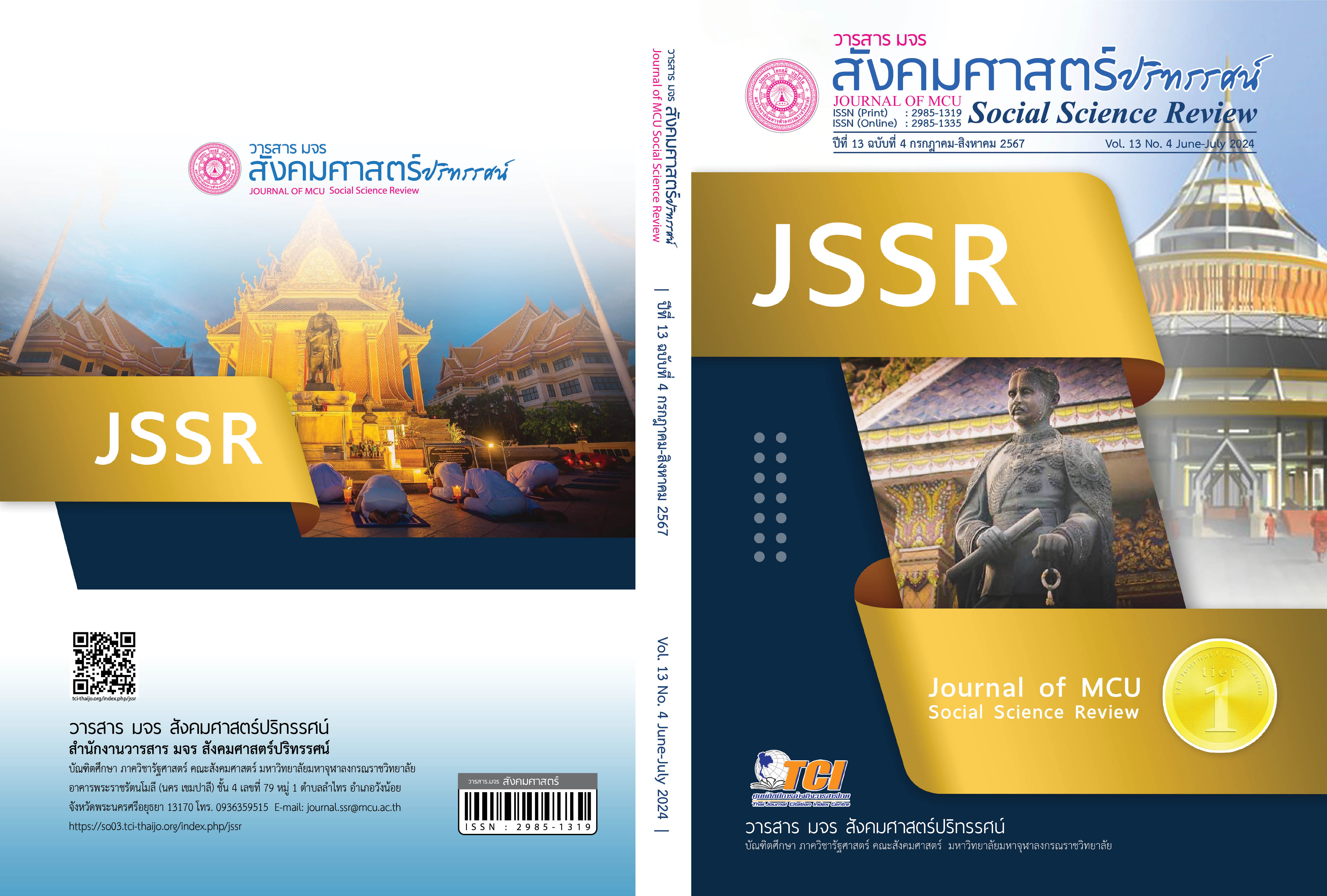ความสัมพันธ์ระหว่างกลยุทธ์การตลาดออนไลน์กับความภักดีของผู้บริโภคต่อเมนูลาบปลาพื้นบ้านบนเครือข่ายสังคมออนไลน์ผ่านเฟสบุ๊คในจังหวัดน่าน
คำสำคัญ:
กลยุทธ์การตลาดออนไลน์, ความภักดีของผู้บริโภค, ลาบปลาพื้นบ้านบทคัดย่อ
บทความวิจัยนี้มีวัตถุประสงค์ 1. ศึกษาข้อมูลพื้นฐานด้านการตลาดสัตว์น้ำของชุมชนในพื้นที่อำเภอเวียงสา จังหวัดน่าน 2. ศึกษาความสัมพันธ์ระหว่างกลยุทธ์การตลาดออนไลน์กับความภักดีของผู้บริโภคต่อเมนูอาหารลาบปลาพื้นบ้านบนเครือข่ายสังคมออนไลน์ผ่านเฟสบุ๊ค
เครื่องมือวิจัยคือแบบสอบถามชนิดมาตราส่วนประมาณค่า 5 ระดับ มีค่าความเชื่อมั่นทั้งฉบับเท่ากับ 0.89 ใช้กลุ่มตัวอย่างผู้สูงอายุจำนวน 390 คน ในพื้นที่อำเภอเวียงสา จังหวัดน่าน โดยดำเนินการสุ่มแบบตามสะดวก วิเคราะห์ข้อมูลด้วยการหาค่าความถี่ ร้อยละ ค่าเฉลี่ย ค่าส่วนเบี่ยงเบนมาตรฐาน และวิเคราะห์การถดถอยพหุคูณ
ผลการวิจัยพบว่า กลยุทธ์การตลาดออนไลน์มีความสัมพันธ์ด้านบวกกับความภักดีของผู้บริโภค โดยมี 1. ค่าสัมประสิทธิ์สหสัมพันธ์พหุคูณระหว่างตัวแปรอิสระ เท่ากับ 0.94 (F=661.59) และกําลังสองของค่าสัมประสิทธิ์สหสัมพันธ์พหุคูณระหว่างตัวแปรอิสระ เท่ากับ 0.89 แสดงว่า ตัวแปรอิสระจำนวน 8 ตัวแปร สามารถร่วมกันอธิบายความแปรปรวนของตัวแปรความภักดีของผู้บริโภคได้ร้อยละ 89.20 และ 2. ค่าน้ำหนักความสําคัญของตัวแปรอิสระผลิตภัณฑ์ ราคา ช่องทางการจัดจำหน่าย การส่งเสริมการตลาด การรักษาความเป็นส่วนตัว และบรรจุภัณฑ์ส่งผลต่อความภักดีของผู้บริโภค (Y) โดยมีสมการพยากรณ์ในรูปคะแนนมาตรฐาน Z = 0.167X1 +0.043X2 +0.785X3-0.001X4-0.090X5+0.128X7
เอกสารอ้างอิง
จรัสกร วรวสุนธรา. (2560). การสื่อสารการตลาดดิจิทัลบนเส้นทางการตัดสินสินใจซื้อของ ผู้บริโภคที่ส่งผลต่อการตัดสินใจซื้อสินค้าประเภทสินค้าประเภทแฟชั่นผ่านเว็บไซต์พาณิชย์อิเล็กทรอนิกส์. กรุงเทพฯ: มหาวิทยาลัยกรุงเทพ.
สำนักงานประมงจังหวัดน่าน. (2564). คนน่านขาดแคลนปลาบริโภค. สืบค้น 15 มกราคม 2565, จาก https://www. posttoday.com /politics/88119
Alguacil, J. M. & Carvajal, T. E. (2020). Facebook commerce usage intention: a symmetric and asymmetric approach. Information Technology & Management, 21(3), 145-156.
Ameen, N. (2022). The impact of service quality, trust, and satisfaction on young citizen loyalty towards government e-services. Information Technology & People, 35(4), 1239-1270.
Carpentier, M. et al. (2017). Recruiting nurses through social media: Effects on employer brand and attractiveness. J Adv Nurs, 73(11), 2696-2708.
Chao, Y. et al. (2009). Customer loyalty in virtual environments: an empirical study in e-bank. Advance in Computational Science, 1148(2), 497-500.
Hootsuite’s Digital Trends Report. (2022). Social media advertising statistics. Retrieved March 25, 2022, from https://blog.hootsuite.com
Mandhachitara, R. & Poolthong, Y. (2011). A model of customer loyalty and corporate social responsibility. Journal of Services Marketing, 25(1), 122-133.
Mccormick, J. R. et al. (2021). Social media use by shoulder and elbow surgeons increases the number of ratings on physician review websites. J Shoulder Elbow Surg, 30(12), 713-723.
Vandevijvere, S., et al. (2018). Volume, nature, and potential impact of advertisements on Facebook and YouTube by food brands popular in New Zealand. N Z Med J, 131(1473), 14-24.
Yamane, T. (1973). Statistics: An Introductory Analysis (3rd ed.). New York: Harper and Row.
ดาวน์โหลด
เผยแพร่แล้ว
รูปแบบการอ้างอิง
ฉบับ
ประเภทบทความ
สัญญาอนุญาต
ลิขสิทธิ์ (c) 2024 วารสาร มจร สังคมศาสตร์ปริทรรศน์

อนุญาตภายใต้เงื่อนไข Creative Commons Attribution-NonCommercial-NoDerivatives 4.0 International License.
เพื่อให้เป็นไปตามกฎหมายลิขสิทธิ์ ผู้นิพนธ์ทุกท่านต้องลงลายมือชื่อในแบบฟอร์มใบมอบลิขสิทธิ์บทความให้แก่วารสารฯ พร้อมกับบทความต้นฉบับที่ได้แก้ไขครั้งสุดท้าย นอกจากนี้ ผู้นิพนธ์ทุกท่านต้องยืนยันว่าบทความต้นฉบับที่ส่งมาตีพิมพ์นั้น ได้ส่งมาตีพิมพ์เฉพาะในวารสาร มจร สังคมศาสตร์ปริทรรศน์ เพียงแห่งเดียวเท่านั้น หากมีการใช้ภาพหรือตารางหรือเนื้อหาอื่นๆ ของผู้นิพนธ์อื่นที่ปรากฏในสิ่งตีพิมพ์อื่นมาแล้ว ผู้นิพนธ์ต้องขออนุญาตเจ้าของลิขสิทธิ์ก่อน พร้อมทั้งแสดงหนังสือที่ได้รับการยินยอมต่อบรรณาธิการ ก่อนที่บทความจะได้รับการตีพิมพ์ หากไม่เป็นไปตามข้อกำหนดเบื้องต้น ทางวารสารจะถอดบทความของท่านออกโดยไม่มีข้อยกเว้นใดๆ ทั้งสิ้น





